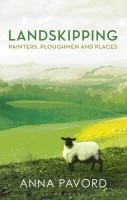Landskipping: Painters, Ploughmen and Places
by Anna Pavord
(Bloomsbury)
 Walkers in Britain’s most celebrated landscapes have it easy today — not because they have GPS to guide them up hill and down dale, but because they’re not expected to take in the views through the eyes of Edmund Burke or William Gilpin.
Walkers in Britain’s most celebrated landscapes have it easy today — not because they have GPS to guide them up hill and down dale, but because they’re not expected to take in the views through the eyes of Edmund Burke or William Gilpin.
In the 18th century, a taste in landscape (or “landskip”, as it was then spelt) was an accomplishment to be learnt, as you might learn Greek or the piano. You had to be able to tell when a foreground was “good” or a background “lacking”, and Burke and Gilpin were the foremost authorities.
Burke, an Irish-born statesman and philosopher, instructed early visitors to our most scenic spots on what could be considered sublime (“a mode of terror or of pain is always the cause”) and what was merely beautiful. Gilpin, a Hampshire vicar, later defined the picturesque (“that particular kind of beauty, which is agreeable in a picture”.) He was famously prescriptive about what constituted a view worth looking at and when elements needed to be adjusted in pursuit of perfection. “If nature gets wrong, I cannot help putting her right,” he once told a friend. What was picturesque to Gilpin, however, wasn’t necessarily so to readers and users of his series of Observations, who were often left wandering whether they were seeing this precipice or that castle from the “correct” vantage point.
If Gilpin was a straitjacket, making his followers feel constrained and inferior, Anna Pavord is a Barbour waistcoat, warming you up nicely in advance of the prospect while leaving you free to wave your arms in wonder. Landskipping, her new survey of the way we have responded to the land through the ages, is both scholarly and sprightly, a wonderful primer for anyone who enjoys the countryside and would like to know more about what (and who) has shaped it.
Her book is in three parts, into which she weaves her own experience of landscapes as various as Norfolk and the Highlands: “Prospects and Painters”, “Prospects and the Plough” and “Prospects and Place”. The first deals with those — writers and tourists as well as painters — for whom landscape, from the 18th century onwards, was something to be looked at. The second follows a different group of travellers, the agriculturists and improvers, whose chief interest was in how the land was being farmed and how it could be better used. The third part celebrates the county where she lives: though she was born in the border country between England and Wales, she now feels herself, like a sheep, “hefted to the hills of west Dorset”.
The middle section features one of her heroes, William Cobbett, who began reporting on his Rural Rides in 1821. He was a lover of England and its landscape — which he believed ought to be useful as well as beautiful — and a champion of the labourers who had to work it. “I should like to have ridden alongside Cobbett,” she writes. “He fought the right kind of battles… I would share his appreciation of a good field of cabbages [Pavord is best known as a gardening writer ]… I would have respected and admired his ability to read the agricultural and pastoral landscape, to analyse what each part of it might mean for those whose livelihood it represented.”
That ability is one she shares. Throughout, she reminds us that most of what we think of as natural beauty has been shaped over 2,000 years by farmers, who have dressed the countryside gradually “in clothes of ever-increasing complexity and finesse”. They have been much vilified recently, but she considers them the best stewards of the landscape — better than conservation bodies, which with their boardwalks, handrails and mud-free car parks are “reinforcing the insidious notion that landscapes should be adapted to suit the visitor, rather than the other way round.”
If she has no time for rules like those of Gilpin, arguing that our response to landscape should be intuitive, she is firm on her likes and dislikes. Flat country, like that of Norfolk, does nothing for her; she needs mountains, or at least hills. She has no time, either, for interpretative boards, which pepper scenic places and wring them of magic and mystery. And don’t try to convince her that a golf course can do anything to improve wildlife habitats: “There is nothing life-enhancing for a plant or animal on the average green or fairway. As an environment, a golf course is a fascist state. And a thirsty one.”
MK
Landskipping: Painters, Ploughmen and Places by Anna Pavord is published by Bloomsbury at £20

Leave a Reply